Sony’s Cyber-shot DSC-H200 is an SLR-esque point-and-shoot bridge camera structured around a 1/2.3″ 20.1-megapixel CCD image sensor. The DSC-H200 additionally utilizes a 26.4x optical superzoom lens (24 – 633mm focal length equivalency), a fixed 3-inch LCD touchscreen display with 460k-dot resolution, a microSD/SDHC/SDXC media slot, as well as enabled 720p HD video capture - you can shoot high-def 720p movies, with a resolution of 1,280 x 720 pixels.

Sony Cyber-shot DSC-H200 Video Format: MP4 (AVC/H.264)
Sony Cyber-shot DSC-H200 Video Mode:
1280x720(Fine) (1,280×720/30fps)/1280x720(Standard) (1,280×720/30fps)/VGA (640×480/30fps)
The Sony Cyber-shot DSC-H200 takes footage in H.264 MP4 format, which is not an editing codec in Sony Vegas and other common editing applications like Avid Media Composer, and Pinnacle Studio. The reason these cameras use H.264 is that they're still cameras with a video function, so their focus isn't on giving you the best possible editing codec. Furthermore, camera manufactories are in the business of selling camcorders, and not so much selling editing systems, the camcorder makers at this level don't really care all that much about the editing problems this creates. To use H.264 MP4 shootings in your editing software, you will have to transcode the footage. Depending on your editorial systems, WMV (VC-1) is the preferred format for Sony Vegas, DNxHD is the preferred codec for Avid, and MPEG-4 is the best suited codec for Pinnacle Studio.
How to merge/re-wrap Sony DSC-H200 MP4 for Sony Vegas, Avid MC, and Pinnacle Studio?
Software Requirement
Pavtube Media Magician (it also comes with a Mac version)
![]() Free download Media Magician Trial Version
Free download Media Magician Trial Version
Notes: The free trial version of Pavtube Media Magician has the following limitations:
1. It will add Pavtube logo watermark in output file(s).
2. Lossless output has a file size limit of 5 minutes.
If the free trial version does what you want, you can click Buy Now here to purchase its full version to bypass the above mentioned free trial limitations.
Step 1: Add Sony Cyber-shot DSC-H200 MP4 footage into Media Magician
There are two ways available to import source media files:
1) Import from camera
Connect your Sony Cyber-shot DSC-H200 camera with your computer and run Pavtube Media Magician. This Sony camera companion program will detect your camera automatically and ask “Camcorder is connected. Are you ready to launch wizard now?” Click “Yes” to confirm.
Also, you can click the camera icon to load footage directly from your Sony Cyber-shot DSC-H200 camera.
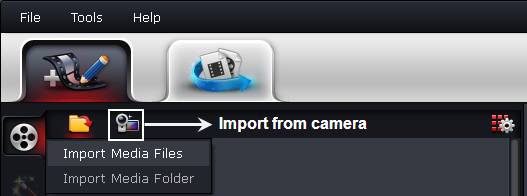
2) Import from local computer
If you your source h.264 mp4 shootings have already been stored on your computer’s HDD, you can click “Import Media Files” or “Import Media Folder” to browse and load your source files.
Step 2: Drag and drop source files onto Timeline
After h.264 MP4 source files are imported into the program, you need to drag and drop the clips that you want to merge and rewrap onto timeline. Keep in mind that all files placed on timeline will be output as one file automatically. So if you want to merge and join several clips, just drag them to timeline in right order.
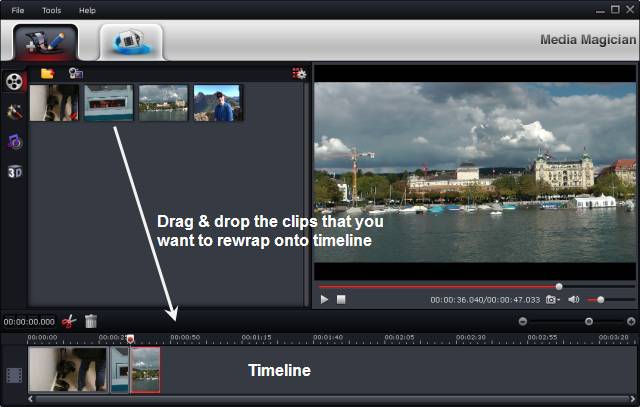
Step 3: Split/Cut/Reorder/Merge source clips (Optional)
If you would like to cut off unwanted parts of your video file, rearrange them in your wanted order, or merge them into one file, you can use the control buttons on timeline to do this.
The control buttons on timeline help you locate frames accurately so that you can cut, trim, delete, and merge video clips in a much easier way.
Control buttons on Timeline
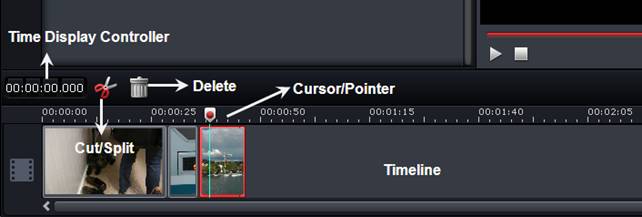
1. Time Display Controller: Move your mouse cursor on timeline, the opposite time point will be displayed here. Once you entered a time point into the time display box and click enter, the Preview Window and Timeline will switch to the frame of this time point. This helps to locate to the accurate frame that you want.
2. Zoom in and Zoom out: Drag the bar on top-right of timeline to Zoom in or out for better view.
3. Preview: Highlight a clip on timeline and click Play button, you can preview. Double click on a clip can also begin preview.
4. Trim: Put your cursor to the start or end point of a clip on timeline until it changes to trimmer. Drag the trimmer and you can trim off unwanted starting or ending.
5. Cut: Drag the pointer to the right place; Put your cursor to process bar under preview window and select the right frame; Click the Scissors button and you can cut the clip. And then you can rearrange order or delete.
6. Delete: Highlight the unwanted clip on timeline, and click Delete button. You can also delete it with right-click menu.
7. Rearrange order: Drag and hold a clip to the right place until the place line shows. Drop the clip and it will be placed right there.
Moreover, you can add 3D effects, special effects (e.g. Simple Gauss Blur, Flip Color, Invert, Aged Film, and Gray), or adjust volume, contrast, saturation, brightness of selected clips. You can also flip video horizontally, vertically, and rotate clockwise and counter-clockwise as you like.
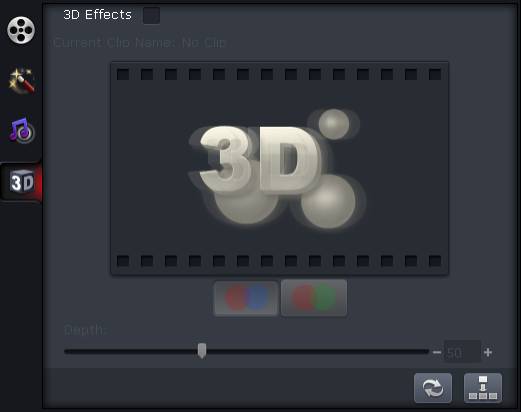

Step 4: Re-wrap Sony Cyber-shot H200 footage to your editing app preferred format
Choose “Output” in the main interface, and click “Plus” icon to add conversion task before selecting output format. Here we take converting H.264 MP4 to DNxHD for Avid for instance:
Switch to “Editor” > “Avid Studio” and click “Start” to begin encoding your source files to DNxHD MOV for
Avid.
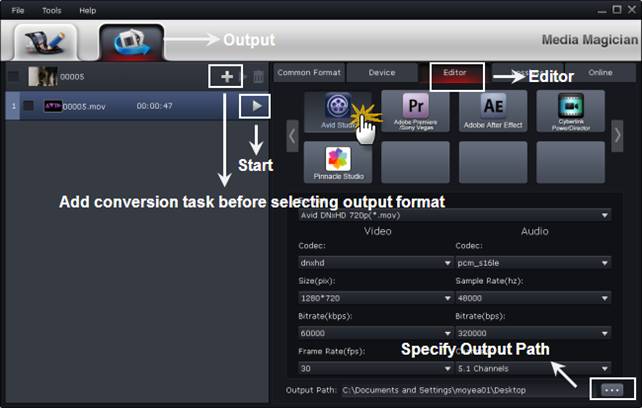
This Sony Cyber-shot camera assistant software will specify a default folder to save the converted videos. If you’d like to change the output location (output path), please click ![]() to navigate to the folder you’d like to save videos to.
to navigate to the folder you’d like to save videos to.
When conversion task finished, you can right click on the task list and check “Find Target” to get the generated DNxHD MOV files for editing use with Avid Studio/Media Composer.
Tips:
1. If you need to edit Sony Cyber-shot DSC-H200 MP4 footage with Sony Vegas, you should select “Adobe Premiere/Sony Vegas” as target format.
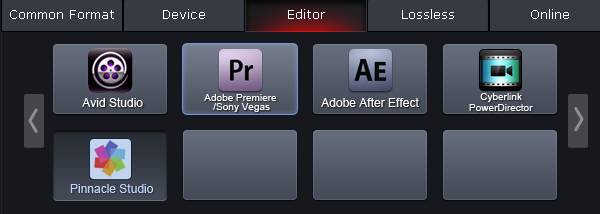
2. If you intend to work with Pinnacle Studio, you need to choose “Pinnacle Studio” as output format.
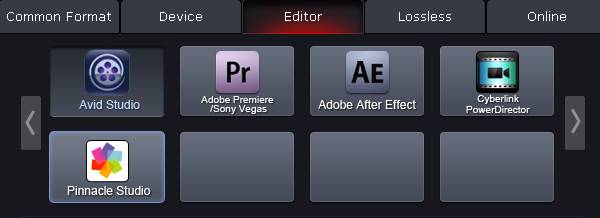
Useful Tips
- Import footages/videos/projects into Final Cut Pro X without rendering
- Convert 1080p MTS Videos to Windows Movie Maker
- Import and edit MTS/M2TS files with Windows Movie Maker
- Import/Edit/Transcode Sony NEX-5N/NEX-7/A57/A65/A77 1080 50/60P AVCHD to iMovie on Mac
- Transcode TiVo Shows to AIC for Editing in iMovie and FCE
- Convert Panasonic MXF Footages to FCP as ProRes for Editing


 Home
Home Free Trial Media Magician
Free Trial Media Magician





